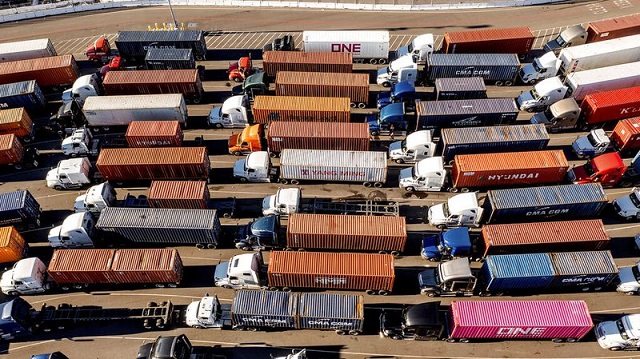
Trucks line up to enter a Port of Oakland shipping terminal on Wednesday, Nov. 10, 2021, in Oakland, California. Intense demand for products has led to a backlog of container ships outside the nation's two largest ports along the Southern California coast. But intensified demand and port backups are not all that's causing the supply-chain disruptions, writes Cleveland lawyer Sarah K. Rathke, an expert in supply chain issues and litigation, in a guest column today. Try the tsunami of overlapping "black swan" events precipitated by the pandemic. (AP Photo/Noah Berger)AP
CLEVELAND -- It is 2021, and the lingering question of our age might well be, "Where is my patio furniture?" American consumers know that everything feels broken, but may not have a complete understanding as to why. Indeed, President Joe Biden stated as much publicly last month, when he encouraged the media to improve their coverage of supply chain issues.
We are in the middle of a supply-chain "black swan" tsunami. A black swan event is defined as a negative occurrence that is virtually impossible to predict, even by knowledgeable experts. COVID-19 has produced multiple black swan events – all happening at the same time – that have fundamentally upended the seamless operation of global supply chains.
Pre-COVID, supply chains were predicated on two separate operating preconditions. The first was "just-in-time manufacturing," under which firms maximized their economic output by eliminating excess inventory everywhere in their supply chains. Generally, companies could determine how much of anything was needed with reference to historical analytics that were reliable and stable over time.
The second pre-COVID supply chain operating precondition was the prevalence of relatively harmonious worldwide free trade, which developed following the end of the Cold War. Free trade explains why consumers today are able to buy more of nearly everything at cheaper prices than ever before.
The COVID-19 black swan tsunami has disrupted both of these operating preconditions, leaving us in uncharted and dysfunctional territory.
The first black swan disruption is the fundamentally changed consumption patterns, caused mainly by people spending more time at home. This change has shifted the cost of the last mile of product deliveries to retailers – but with consumers expecting that product prices will nevertheless stay the same.
The second black swan disruption relates to changed labor resources. When COVID-19 hit, the United States was partway through the retirement of the baby boomers, and most of the way through a transition to a services-based economy. COVID-19 hastened both of these transitions. In addition, with child care becoming less reliable, COVID-19 forced a mass retreat of parents and particularly women from the workforce.
COVID-19 has also put dramatic strain on our worldwide logistics networks – the third COVID-19 black swan disruption – from unprecedented port congestion, to a record-breaking need for transportation workers, to insufficient warehouse space.
The final black swan disruption is to the United States' diplomatic relationships, and particularly with China. And while the United States has undergone periodic chilly spells with China, this one is likely to be more permanent.
China's rise to manufacturing dominance since the 1980s has enabled it to improve the economic well-being of its population. However, China engages in certain behaviors that the United States does not – and should not – like. Meanwhile, China's economic prosperity has driven up its labor costs, making it less competitive as a foreign manufacturer. On the other hand, China's successes have created a robust consumer market of China's own, and China's president, Xi Jinping, has made clear that China intends to begin prioritizing its own consumers – undermining the notion that we will ever get back to "normal" with China post-pandemic.
It is not often that people at the precipice of a historical inflection point know that they are at the precipice of a historical inflection point, but now we do seem to have that awareness. Getting back to functionality with our supply chains will necessitate improvements to automation, likely starting in the warehousing sector, and increased end-to-end supply chain information transparency. The technological underpinnings already exist for both of these developments, and the cascading effects of these improvements will likely be substantial – and will likely produce black swan impacts of their own.
Originally Published by The Plain Dealer and cleveland.com
The content of this article is intended to provide a general guide to the subject matter. Specialist advice should be sought about your specific circumstances.

